#l e a t h e r m ø u t h
Note

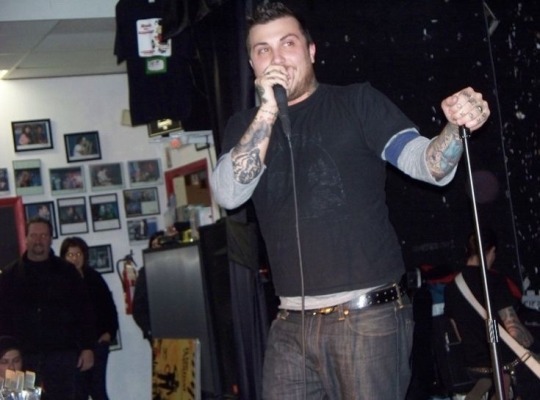
oh. hold on. let me just go set myself on fire.~🎃
#LeATHERMØUTH FRNK#said with increasing volume#lm frank#leathermouth frank#l e a t h e r m ø u t h#f r a n k#frnkiebby#rosethrorn#asks#frank iero#mcr#frnkiero#mcrmy#mcr5#frnkie#my chemical romance#my chem#ilhsm
24 notes
·
View notes
Note
Todays gender is
‚
À'Ë|ºì8íÂ
AN`1_Ýinr„/î´
79×FwÚ‚œÁ’à´79„#Çinr
s¾4ºÓ*Üä_ÝinrŽ/î´79‡77:xW
_ÐÄi*n: 4áIB+_C.
59§;pCÐ!ð•"_+¶Ši¦™¦&çtn:_Ýin:
_Ýin:Ö<ôMœF↠т&L"ÖC©É?ëœÞÁ
A‡â
š8Ä
AÓì¥ÑKëœ|ㆠégiôR
k$n
ò‚.` K£g{ër®Ñ4+_§~Üt _Kn:eA7ùÃ
A—ÀB&ß
÷S_ÐÄnºˆjOòÖ«>y«W/↠ËhÄÒè¥&«F©4Ö•#kÚåz7]Hµ¥ÑK ¿»)®qCÐ
¥ð$¡Ô‚&¥zhwý]/↠KùÜ> ç
J-hRª
Œvß
¨«7}£\/↠K¡gË>IPo÷¹Ï}®¢³=£¶S<a÷ågÓØ0ÅÏ:”°Tx«]/↠ËÌÒèêÕCþßÿý_¿žRû6\ûÚ¶Ø8öû
ßÿþ7U
§5¸!èº4º“Þÿ¿ÿýoªäòQÚi§6íAééÙ‡l¯ª‘ Ny+
d H¯üÖ2MrÜw Õ.›”l° ü(¦ò¡<[&ÊŽÒJé?øàƒðú믇·Þz+|òÉ'1=Çfžyæ0Ë,³„¡C‡
†ÙgŸ=5@zÜç?ÿù˜÷gŸ}·³†Äi>n:”j—’!¨å’G=¸öQÚ/|¡ÿËJï¿ÿ~xüñÇÃÍ7ß
Ý?þñðŸÿü§x4„9æ˜#,¶Øbaå•W묳NXvÙeÃüóÏ †Ÿ2‰Éˆ d$j©_3
©×ˆv"n:”j—
C€bª—FùQP¶qê?úè£ðôÓO‡
/¼0œþùáå—_Žá• N€Í7ß<lµÕVaÅW
óÎ;o<¦e´[Ý8
CµËV!RN
Û
Àe—]N=õÔðÊ+¯D£A\•‰O|œÂ
T¦n)`Ë-·
»í¶[X}õÕãmp¬ÝŠØîòÛ‚¥Úe«$ÌÕÒj¨2ä÷ᇠ†Ë/¿<
sÌ1áᇠŽáRl{_/EÂIK™
g ÇþôÓO vØa‡°ãŽ;†5×\3ÛN¨C¯á† Mä©Ù©‹þRŠðâ‹/
†K/½4
tÐAáã?.†NyB c€¯ô•ÎQqÅ"‹,~õ«_ÅÛ†Yg5†)}«ƒ§%´»É)ß
;# )´TûÜûßÿýá‚
.ˆ“<¨ÊÖí„ NŒ>~ö³Ÿ…½÷Þ;Œ1"5*j¯V)¨'WT»4•¶
RZÒéñ
Ž¸R~¶ñß|óÍpë·†³Î:+\{íµÅ”}i«Õkã
B8æ¨æŸIÅN9-„ßÂ;ïö
W
ø
jþŸ¹ƒ£Ž:*,¾øâ1
dzO+šI¥víZ’†vrJ¢œ]%JÅ—K®«/^¢hÑ“&M*
Œ
=º()ŸºDA
䢚
˺_þ<þ÷v"Vï÷N(\uQ(
2%
y)¿ÄðÄ0|ÂØÞd“M
Ï=÷\±F}Po[Ïrè<Ë9gj|DÐòÔÄÔ…Ñ€zØD1â ŸžIÀ#Ž8"N
a8 ítÓM>ýôÓ²çôßÉ
L0w,Iôá_
áä8ÐóS&ØÛêÅÈ ÇÈ`üøñaî¹çŽåQÕ·ÕÚ[çãL¡r‹:u@VÊJH ˹Á@:”P6)Šù裆ïÿûýŒ J§òˆË0½Ò9M[J¢’ª~üF§¸›äEÙ”
I^Õƒü9W]uU8÷ÜsÓzÖbœÁáÚD¤@ƒuÕ(•¦'¥¢'ÆñXð
¿ýíoã[‚Êè¡ÕsF|
+ÅÇŸ7d+ˆšlO›øI1}AÅz”r2<¥œtÒIáÙgŸû¸JFHdóÌ:gjÜô(ôÆ
ÀÀÑG
FÎ>ûìTé9ŽÒð¨_ Òm
6¶¸!}+Fýã„>MFzPYôü
PÜk¯½_\zä‘GâÈÁ¹I$ÕéB…*nõ‘(Uq«dP¸ì²Ë
K.¹$ªšºD)Ó ;¹¤'îçWsû™,<
õ„©ãΖ¥ü ËÖaùå—/œx≅§žzªx¥Éž§¥Ò±^Ç'
».)=«z} ,Q´¸ýüóχóÎ;/üú׿N{|‰
22 notes
·
View notes
Text
Medieval Runes, Quick Guide
ᛆ - a, á
ᛅ - æ
ᚰ - ǫ
ᚮ - o, ó
ᚯ - ø, œ
ᛁ - i, í, j
ᛂ - e, é
ᚢ - u, ú, v
ᚤ - y, ý
ᛆᚢ ᛅᚤ ᛅᛁ
au ey ei
ᛔ ᛒ ᛘ ᚦ ᚧ ᛐ ᛑ ᚿ
p b m þ ð t d n
ᚴ ᚵ ᚶ ᚼ ᚠ ᛚ ᚱ ᛋ ᛎ
k g ng h f l r s z
This correlation between Runic and Latin letters is not 100% historical, since there was no one way of writing Old Norse and its daughter languages.
Medieval Runes were used after the Old Norse period, for writing early Norwegian, Danish, and Swedish dialects of the 12th century and later, which have already underwent certain changes. Also the same letters were used for different sounds between each dialect, and some letters had different shapes as well. So there is no correct way of writing Old Norse with Medieval Runes as there was no standard orthography, and this one is just as good as any.
What I have devised though is the simplest one-on-one transcription from Latin to Runic, though backwards this isn't possible since some Runes represent two or more sounds, which are distinct in the Latin script.
7 notes
·
View notes
Text
introducing arissi
vowels:
/ɑ/ a
/ɑː/ aa
/e/ e
/eː/ ee
/i/ i
/iː/ ii
/o/ o
/oː/ oo
/u/ u
/uː/ uu
/y/ y
/yː/ yy
/ø/ ö
/øː/ öö
/æ/ ä
/æː/ ää
consonants:
/d/ d
/h/ h
/j/ j
/k/ k
/kː/ kk
/l/ l
/lː/ ll
/m/ m
/mː/ mm
/n/ n
/nː/ nn
/p/ p
/pː/ pp
/r/ r
/s/ s
/sː/ ss
/t/ t
/tː/ tt
/ʋ/ v
arissi /ɑris:i/ also means hedgehog
6 notes
·
View notes
Note
Erm, treat or trick?
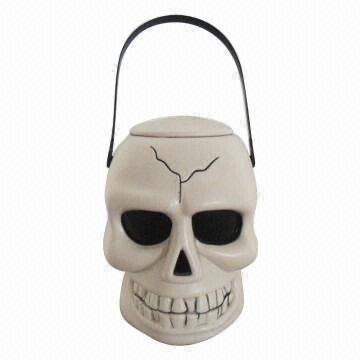
HELLO!!!!!
you get a png that i had in my downloads folder turned into a text file!
‰PNG
IHDR € 'úÊ R.IDATxœÕ½×–$¹’®÷A¸{¨ÔUÕÕb«³Gò,^‘|$Þñø ‡³¸È3sf¶hQE(W xa¸GfVuu÷žÙCÔÊÊÌÈw 0ñ›2ÿçÿñ¿'t¤”ˆ!B"•W!¥Hš½âô³uV2c¦a bH¤dpUÍz½as~Áj½¡^,hªë
¤Hˆ#1F’1Œ1Ðv=Ǿçp<p<
ûœÇúëk¬«qU Æ fÏŒ¼B2ù™#Qçb*s2Xâ(÷
ãˆ1©¼?Å„I–qìGÆ®e
Æa „@J ç
MÓà½Ã{Gí+*Wá£vïÀ™H ¡oi{ÚÞ®=0
=$Y©Çà Ó2RJú<‘” ‘ˆ@²
cH1S$„ˆÁ±úù$×O@JÄ R’5óÏÜûÙÇ1ºÈ)%Œ5ºÞ©üýdáS}€gG‚cùJH¨›c$„@#ã00#!DbŠ˜$ÏÐzîòy£™h"=ûÎÙÉ’S’{(‘ÀÄé]ùÚÖÚé{¢Ö€·òƘ¦ý’ý4ŸG ùd
)Ÿ„NÏœ¼G†
0晘‰Lb"…H
è&ÊƧ…8’l¾A Ä@
‘Aç" ù‰g.
+¥rj aèfÉ
tÓbœ8ÝŒjÒlé§9&0 kŒž°(»’")p–”1Z’5$äô–ýŒ5ÏÏ;£0r›˜ êZåùÈZ 8ë°FZ8ØdtÍdoŒîÞ³t��æ›jLÞ@aIò§0/ÆXÙ¥NC¤$,1…@
묲9™pˆGbòZÔňl>ŸÚþù<ä+¦”?HÔ“žbÄdn4{OR¶lRqv·LHysô÷IÑÈïÆR’Å/sËDiŒžbŠä:™1z¢ÞQÿ®› Rd
‘åp
ýÀ0
„Qˆ¬®jꪢò
[yV÷Àè¹´åš@Ÿèc úìvçÏ})‹GyE_0™)Fù§é,¥Dˆ:±ˆQ¾²üžôó§hÚ¤¹
è⻌"Oîšb,³ŽÑɽ–~Î ZNϽ+böÑퟓ9 cé‡~h‡žãñÈñp¤ëzB
uU±^8_o8߬ñ%¡
SžB²EmZVcD>Țز½I?œùÀ)$?´1ıƖE´Æß6kT+›!,3YʨŠŒ(4I&MÌë¥Kh
w™Ÿ(Y¹T^1¨’'¬Ù¤8ÓYDÜÄ‹| a“±(Mr
£§åÄ J˜¤ˆ³ÒÉc’(³²Ž©(Q¹XLMV Ñ]¡ åFº[1%ÆèûÝnÏþxàÐ
iÛŽnìú‘1ÈšÀ9Çáx¤ë;’MàÎh\u²Ï¢F‚·ª©$ ¥¸D"‘άuªôpò€Îªb¡,Í@$Ù#S(9ËücŠ¤lu$Uò"êf=@†,ŠòNÏN–jfÒð…u›I Kä“zJÇzí””0 1¨b›¦¯™x! “5Lß ’hç™x’i"r”p³lòÆÇ¢öEã8Òu=Ƕe¿;°Ýî8
´CÏFÑüõѲ¾B¤ cŠøª¢ª*ìÒâr‚Ù³ Èk-1É0]ß3tý8({¡œnk-¾òT¾Âƒw
çÝd-¨Î0×#TWN¢
R”£¡,1)ä-ΛºodTvª&Í\&‹¥¯–Í•º;?¡#Ü!FRÈ'"Ò™¦ é–Å›p¹¬î‹5‘fÏýÈŠ1“)\OO|Û÷ì÷{ý:°?
éÚža‚<…ALº™R‘HÄ9´
»
ëõŠE³ÀyÙëIÁLx1Áʹ FÆÀnwàööŽ‡í–¶múžó)9³\¯Ø¬ÖTuEUÕ,
‹k
ÖFœ3xï'=¡œ˜lt%0–D+Ïl<™8V•E¼FÁ¬›ŸèiLÿô{–ɤ$ ¦ÿ&Âœ}xö=• Ή&‹BåtP°”Õc¢(«ª3Mc¬^AïQ
y¶Ã8phÜÝßswwÇ~w ë{FÅSD‰´åiR2ªà©šn¤À#‡¶åØu„1Ö 7RN àŸhŸÆÒûÝŽïß¾áýû÷
GúaP™ªwŽ¦®Y.x_Ñ4 ›³3./.X–4uC]×Ô)aèÿÖZœÉ2PµoL]òi5Έ]( 5]N
–"4M>e³ÓªÄ–ÏD̦Ÿ²ÚüÚ´y#D¶#Ï›Rd:#Ï©ž©˜•†DŒ†h=)ÙbÕÈþÊ©ÌsJbdŒ
ª1mËî°ça»åþáínGßuÄDÙôr½$@–1Nô"k…$Šâ62Œ#ÇöHÛµ,ªªo&aot 2¡F Gî¶[ÞÞÞr{Oßõ„ dqß
p{Qʪªby·äìvÃz½f³Þ°Þl8;Û°\¨ë† CH†&åZL
QS
a–²Ùb±8Œèî…䯙 @–›)N wŒQNf‹ºx¢Sdír¦èkb¹X¢ÉšÈ$7SÌzQ$Y§Ä&8Å8‚3†h¬|zºÉïQ4ÔpÄåÔ |¸»åöþý~OÛµtC_¤#ª¢
È$srÖ¬Å:%‚,žÔÂI1Ç@
FùnL«&)8gp1%Ú¡ç~¿ãn·ã8Œ„TÎâL
&Æ Œò·¾g׶Üï¶ÔUÅj±dsvÎÅÕ%WWלmÎXÖ¬Œ§^¨Ý
ÆZœµªÀ)·¡àG&MPf–ßYÁ+àùTŸêbV&1žÍÌ‚)gÆ›³Ö¿Å˜o|6Ucœ4/}BöêŒÅ$CŠ²É™X“™0ˆ˜!Â]Û²?
¸{xà݇ìö;ú¡W©Ï”õ†"¾¬\ÛY¬ÕŸÁ$ƒIQô+Õé më:¤Ù ø2eý/¦HÛ¶
Zaû1åËöìãá2=¦
‡#Û-ÕÝ
«Û\^|àââ’«ËknnnpÎã¬|®©Ü´þº˜CfBdG…’˜^!°1XŒ³2)ÄÄ’'ÍvöS9[dúlâÊ´2¤Ô“æ^4xݽGŒQý
Â%ãè`U%ʱU…wˆ‘1Fúq¤íZö‡÷l·;¶û
ÛÝŽQQʼùI9SVÀ'.ó,›¯s5Ö¶Êú<tå
¯IÑ•Bdè B7H£M³Óñ©‘”BŒÄ¾c¼O
ÛŽÛ‡ >ÜÞqwwÇñÐñâÅ ——\^\Rו,5ÄQLí#½Z"ãÄ'&Ù,og²<µ"'UYœtº™Â7'€²é¦ ~…ã¤8Æ0ÆQáé¨æ—M†HÛuŒã@Ôç Xàºi ±ƒ@¶]×Ñw
Ç®åÃÝ-÷w÷
úadÔõ±ìætü!}ͱN忨֚9‚ƒ5^8Âã½|>Ùæg¶Ó Ê Oñþç7ŸYÃ-]?r<´ì¶{öû#·w·¼zñ’ö‹–‹‹ V«Ö:ú~¤ë;ÚîÈ~¿çp<Š‡2F0ŽÕzSäaŒ#ÎWû·Y©²3±žDóÕqJªDÍ–D9Á Æq E!¾aèÇ‘q
F9
Y¨´‡Çö DEƒç,uÝLÚ¹* ]ÛÑßn÷;Ç}?2&0_Yóèûô›QlÆX«:Ô47nà¼Ç9ÿDßÅ€WaWN®Áà¬Ã9Qî„M΃çÆô·|¤
$[^I ÒhC¤ï]?pÿðÀûwïy÷þ
¯^¾ââòšºªiÛ–cwd¿ß±Ým9
ŽÀ:O³\qÞ¶x_aÃ{9’±Xg±ÎcÃùJ «lmí[
&³n1½„P³‹ØÄ@ †¡Sˆ´Ý‘öx¤ïníÚ–q
å1¡
„ Ì\•3ÅM¬#}/Ä”#$k°•Ph¦Ÿ
ðÜîM ³Ãš•Ìˆ3PWõ¢Áוu3ј>s»ùE+ïñ¾Â9Gˆ kÅdùؘ}
cÝ©-¯2Ì rðxl9
:>¼¿ã‡7?puõ-WÔUCÛv
CDZ;r8¶ô}@]7¬×åBõUUá½ k¨ëšÕJ,Žf±¤ò5ÖzÛ²â$²ÒY[^!ª¼WNý]×2
‰Èá¸çþþŽý~ Çã0b0„0Ò
&39¥8ómDBŒ8çðÞãxâDÄ$ñÎ×8—Ôë9©zò|A×ÔQ-P³=FœgsO¥M‚8â
«Õ’ÕjE]U8yóÉÞ8ƒDÕ34UÅr±¤©†>•¥}”|dd
-˜|~ĬU‡È~¿g··[œu¤ H€F† ú~ m{îïï!E¬1‚<:¹nÝ4œ]°9»(„²hTU]ì~c
ÎyŒžÊ#a
†qRô‚°ü¶=ÒvGB9¶ îïg
F†a &õsd«E}€âà
z)ž¢®£®Ë<ˆ¥@ʌ͌ËbM¶r
Ö8P/^f
ÖŒI§¢Y c-Î9ÙÇFƒnÊæOÖÁ©70 e5MÃj¹¢®jà˜Õçlóã×eb•—çø‡,L¢í:Ú®' ‘È"d#BÇ02
=):0rr¼óìv[Öw¬×眱ÙlX®–ŠL9‰Îœ““3Æ~d
âz
Ç ÐñÈáp íŽ
COÛµ
÷ Úã±DMÇd÷ä´³à—}'1Bre‰ŒjâÏï—Ïfm?˜édåzè½òžg0 ®‘¿yçY,€«(–Cyú¬"špÒÅ^4K.ÎÏØlÖÜow„qüÈfj(!”³ÿ¼+%Nï7kÄç` ekèIæ
¨C)& 2Ž}ßÑõ
‡Ãžíö»û«ÕŠårI¥ï=Þ{qŽXY°¡“¯q
ôýÈþ°g·ßsl[9éqT_û¨€Ò‰¶3{Æ<’ê€3SQ•ìâ#Ïv¯Úäóu•ùOXÄôºÅ¹™g¤ˆÑ…“¨•Ô4µ ²Í¢„Œ•@4!~z"[
®k®//yysÃý퇽€
Y‡à‘xúãd—ëÿø0³ /ض1¤ˆD¼4"H|Š“}+vû#ã(,Û>Üá¬ÇåM÷•8¯OÓÔT• c»‘®ë†‘a¯zÆf{5ò§ŽÀÄ´&VŸ¹—
K+ô˜2K6¾–Yö«ˆS+Ÿl²-Ônʽ³ž Êaæ©8ˆŒÞËX
”3“Ù' Áª,W
Â$ 6ù^ª Êv‘‚Jíj*g©£vNâÒÄ%DìL&½Ÿj:ÎVTL–‹†«ë
´}K8ŒÅÉO?B,ËÆÌdT–›smÕY1a4ôDÿ×ÓÆdð&ê —Œ!i`êL‰?Ü2ñ§çµµv
ŸÐ.ŠÛ–“ M‚v6/ýÄX9¡“‰™Êdz¦.ß'ÇÍÄËRáÉx%T
€‚ÁyTæ‹
òRTâA•>4’œ±šîðÖÄv¨®¬×:]“§A¡ŒVU{ÎÏ×\]_rèZ‰®ëÅÖ4à3ÎÖ+£æéÊ›È2ß@á@yfù$è:b?D±yåRšs0‹Ržn’=‰OåjÖУršSÍx²>ærr¶ÓÍ®ˆ'›oN>3±ÅÌA&.ea]@ÍåD’ E£œO1 ÆDŠc!¬„z%£ÀãÞ¼s4uEÝTx'˜‹)Šxš
k³ñ|X¸n‚s–ÕrÉõåÃ0†Û‡ º~€$bæDúdãóe£Èì”"!cÏè>1*1”…šÌŸ‚Œ=«WÎMœGš.œ}ò¹Lók<÷žIODR2J@Óücæ(&“ÐÓå
hú=D‰!03"PNP1 ¢f†hÎâ bJ¢3˜Œ‚Š~c]F ó]ŸWÄŸ@ÌŽzÝ ï*6« ýÅH×ìÛŽ!!Á!*'È÷0𶜯€²[£Ô®>ˆT‚6³ìˆE›q¶µ*6Š¦m‹~¬ßÆøO¶²˜@s0;å3‘·D_tæ lœÝ”5J&ÍBÅæ‡ }j½§÷”;«(Š§ywš®YÄÔL\™”°VAï,ÞZœ1J#“•ÔE-ìkÊð“]+A
9„º8!ÅWË¥ØÕ‹º‘Ô„ gF¨uZ¿üÐϯÀ):,³ŠL1w¦(iö™L
™kûGÈt Qì,iÐm“ý±Ç|wds {É>õÜ™ÏOÏ3·ãÄW6{Î|ÒåC%‚Iÿ
«ž±ŠGì;+‰ OUyêÚãÕõlR"…$Þz£©bY,Š¼–þhš@6¿ÒlF"MÃzµd
ƒ"g¢±ÊÆMטádŸX†trz„Õ²iót1g
ž
Æ‘™¬¤žžôÌ‚áôôÿ¼ñc^Ö<ʪ«A¸²©Î9šª¦©jïÅ,ÔCdÈ袙\ÆÆ©?ÅNy9¤ÚH
ta-&¬ƒªv¬× Æ8€1Ž
#ÄñT þ¼QàÌÈØ÷O»†Ì!ÿl˜'ò¿SE-Ÿºü¬O7?‹˜
eÈI:¹gþÀOóÏ z4Áœ,£òÎZj_ÑøŠ¦òxç4š:aÕÜuF¢®¬Óà›œ ‚Š Dɾ1¤ÉèDS ‚2i h?Žô]Ë-Ñ„’)“õÀô
¾iS²ÂÇå1(û„rz…[d³JX^Öä%Ó¨™•…h!Y®¦2ÏÉoŸÅ‹-§¼hèO¾~ùxb=;¦ù[çpÎáŒÓÏZo©¼£v²ÙÎZ¼sTN\ûÞ{œšÁ1ªç1F¼
ŒiBqa&ÍËf®#6i CåXÔq¨ †!ˆM\öíÇÚì§ÊسËô躦ly~ÍÌŸu€ £pÓb,aî9
Qxvœð™Neý”$2ÿÏ”ë>™ÌçŸ}$9%Æap¼1TVÀŸÆyšªfY5’ hô
ÖHR®AŒq
Ÿ¶Âh—À«¢\Q#$a£rŽeSc¢¦]…À ‘Ï$ ýþ
0ÝýS²pRØfN¢D À0j}ı9L:Cª6‹‰é
ÑbR¯b–ãù²º@¢|f5ë§"j®û”Ÿž/ÏÏg"€”Ô÷ÿ©Ï ȧ¢µ‹wPYCí,÷Ôγ¬–MC]ÕåÚ1Â8„4ð¾P°Aw–ª”§à4ˆ¢öŽÚ׌1| Vj\7Äq$Å‘!†åñßg<"®ÌÝ“FØ
B®Pðwƒó^H#±Ýgѳä“Ö>åJF3©²ò›MÚÓ÷}
G¿„
?¶ùùºòl:ÿ(‰¥•uTÎSWžÕ¢aÙ,ðÖ’Bú8Ó’l|æa~ò\ …E;ù£åÍBuÎ9¼š}tx/JH¬%b
G†029Ùøé¡ò|vÚ
˱´bïÊ4¦€” òxÓžçDs§Ðô^[Xös¸á玌YL¡dÏ‚PªØ‹AskCåkÍ’¦^à‡$±1œ&µdëÇ
bf8 '§^#•ŸEñðUM³&YBbÛ]å°½ƒà(¸À¿Ë˜iû3sSÐç¹b—ß›Ï:AÐß›ª™mŠ~ü>5™ r‚Û ð5× ~d&ÊöOÜ(“/¡ì(Î{šfÁr¹¢©œ±R"&bÅ)êÑÓ•Ÿ|FÌæØ»ÈÆé!³+µª<°0dU,R„®ï%ìØÚ'‹õq¥æçŒBËNczò®”R‰÷=]SÂQ«ÀÇÇFI2Õ»²e¡>‰Ïõ?:£4‰§ÇpJ
2OÁ
˦a³Zs¶ÙHÈ0ƒ ƒúfº· AÉ@žÅÐXølúé›I¼>ë.âcÄW
×{qVX‰µ³®"Ù^Ójâj~<ÁOQü3KUB& œIÿ61²OÛ柿iäÍ/9 §žqòjþø8—Ÿz6á9†ºòl´ðòª!&ºc ÎRy/z…uLJ¦9= é”nýG 8{ôÓÖY
CЬPªn£)JÞÑÔ E10Žã‰l{<ÁŸ¾YcŸ
z–<5½Z6çy,aŽ}̦û˜U”qj§Ës¤h ù13#UC䱆ñ©9=.Å3ÖÌq
†Ú×\œ³^ðÞiB*’ dd!‰Ÿz‚—d}~ˆ²(&i †Òr&Ò” 0iäìÈÐ÷ôCO×ËWA´Zµ SåOÜü§"ãñûO¯,
ÊÆ›l²åܼÙç "hg÷ÉÁ“ÈÊúPÞ„2¹ñÌ2Ùq”>Ÿ<½Æd&:ç¨|Íz¹bµ^@ÇÎz*ï©ëŠÚW
”&îG†—jV±ñ”FYOñ[Œa(•»†a í:û»Ý–Ýñ(©[Þ‘’lú|áâL•ˆ™G²éÇÇìÁžðà9ëuå]ÖLÍ
šÈ€‘w^”±H©ÃW,c%k5
;Š‡²Ä@Ø|Á9g™0…“P¸Ÿ@
'3ÎÑ,6« ËfA ~
i*/é÷VêzE Éeqža„Ï<€—bLB ¶XöTi@³YC m;Úc+i^»Û”,Ç@H‰Ø À’ï6¯§7Wt²ücæÏÓñØä:uÐÌëMCÃÍõþX)IY—™™~ùç”ã
ÑfrBKJ˜J맫Ÿêñë§L\È{/E7–KŒ1’?Øv4U…· !HÀˆwBÖi(ÛÌÉõ¸z<| @4:[=G%¸A3rCû@§p8
8ì´ÇVʓ防ge&¤N@kbìÂ!2 òØ$ÊŸ9•½?6&< 5á"¢»ˆÛ5³ƒéH¿{‰
œ6ï”9MeßæÃ9KÔì©R")ŠøÌ3Ï@ÌÙÐÂù¹
TU¥WÄ8´ ƾ×òz#&E\‚u]K¢‹µ%)Ô$ÑœÖ<¹g*4çB«¥HDöu'¡ž˜ä‡‘¾ïõôK®\ÛµôÃ(1ivŠœãã'ŠW¾ýìçL@/Y\<ŸÏTÝbžD}®("™zvƒb*áCó5
×59$
’žr)V2=ÑŠ Ò|åY.—ÔUÍ0¥D1àc
AÂØ+©–+¬f7‰›|LψŸN4ØìU›&óç†a¤í:v‡=ûöHÛu
ÃÀƒ8ÒàüÜaÍz@ÞÜ)D{â Þû¢_dB˜‹ˆë ójaó÷š"38ôD•|¬å–Ó?Å-æ,@³p§Âa”·%êÆdç¶)ñ‡å™ AÍæ¤ï0¬wÔ•x[«ªbv»
Ã0 Ö¸-šÞôƒ¤¶Q°
3c?ùGŸK¿Ê“$§7»N„8JòÄápdhÙ·Gö}G;RàÙ䤢ỗÌO[Tó1ŸÂ¬ífl|þ>yø§›<ÓÓ_b •gÔ +bEÙ l(‹R6_sû½zÒ†q$¥áYË%>Š_0ÆbMNÑR‘“NÂ’ö¦0²uB8•¯¸¸¸ÀZÃáp¿—püôdÄf´,Œ1†aéúEÝ*yÏdÑj(: ?˜Op€Lís{4„(µêŽ
G:Õõ=c
‰F(ñSÌžÌâ3ë ÇQüÖN2s
è±÷ð” >.
&" ]œÒÔfÄ8QùÙ”ø*à×BaS‘ËÇ·œRº’µ'„‘Íi!tåLª\Z+KÓ4¬×kªªf¿Û•“?OÏ'&¢„1\3Â(–>—3¦(ôù³b¾fwý$ÒN³ƒg Jyúa¤
Ž]Ǿ;Òö-]ßÑ
>1O´†ôYDp MN²8Æ('O9BÓÔêlÊâ ?d9déSEkÒM&%ñ LïFÒºƒ|0Z&¦ ÂiNn”ZL!¶<ŸÙ‘óS+zY+È^³X°Z¯ðαÛíØï÷ŒÃXˆ&›æMhÅ0ú Ŷ0„˜BÈ
Ň)ó*ÀPÞ+y¹@N}ÊšRˆ‘a8´
‡£²ýöÈqè%w.ŠìÀrèØçlø|<ç+†AX¢jÂb-Då±T+6ãÂYÍÅ
í#“V·Jé(MÄ{òwIN –!ÄbáMÁœ“ž³"Nç2‹ó=•¿Vbø«ºbµ\q~~†óŽ‡í·wwÄ8Š¥IõI 5R‰,DÆQ6܇Àà
Ã(%áœu9qªAœrÍ¡§Š¸Ÿ¿ fS"âÀ¡ïØ· öǃ²þ–V“'Ã3HÓOaÿŸ3Æq¤m[꺦i4Í‚®ëhÛ¾@ÐÏ ©
8 notes
·
View notes
Text
Pronunciation things
So I can't possibly explain everything, but I'll mention a couple things
Generally we have more like, easy to understand letters than English. "a" is only "a" not "ai". But "o" is both "o" and "å".
There are some diphtongs:
ei, øy, au - most common
ai, oi and eu - less common
There are some ch type sounds:
kj, ky, ki, sj, skj, ski, sky
most of those are different I think
There's also gj which is basically English J I think maybe
If there's a double consonant that usually means the vowel is short. (this has exceptions). And the same in reverse.
blod (no) has a long o (means blood)
Bakke (no) has a short a (means hill)
We're not french so we pronounce letters at the end of our words even if they're vocals.
Norwegian alphabet almost explained
a = ah = a as in arc
b = b
c (we don't use this much)
d = d
e = e = e as in end
f = f
g = g (can be not pronounced)
h = h
i = ee = ee as in been
j = weak j idk = y as in yes
k = k
L = L
m = m
n = n
o = o (1) or å (2) where idk what 1 is actually and 2= o as in not or morning
p = p
q (we don't use this much)
r = r (there are two versions: "skarre r" and "rulle r", idk the difference but some people care a lot, I think it depends on dialect though so it's probably fine whichever you use)
s = s
t = t
u = o = o as in to or ue as in blue
v = v
w (we don't use this much)
x (we don't use this much)
y = y = y as in penny
z (we don't use this much)
æ = ae idk = au as in laugh
ø = uh = u as in blunt
å = o = o as in not or morning
3 notes
·
View notes
Text
SCP Anthology in 10 Words or Less
It’s been a while since I made a post about SCP, I know. But the recent Halloween event for the ABC’s of Death was so cool I just had to come out of cryogenic sleep to post about it. Do yourself a favor and go read these for yourself, you can find the link below, but read along with my silly comments if you like. All credit to the original incredibly talented authors, loved just about all of these, and T/W for mild horror elements and spoilers.
A is for Annihilation: The true doomer religion. “Existence is evil, man…”
Æ is for Ærials: This is just what Chicago traffic feels like.
B is for Bloodborne: Don’t seek immortality. You’ll just get all moldy.
C is for Closers: This one’s a fixer-upper, sink is haunted, wallpaper’s peeling…
D is for Dermatology: GET EM OFF GET EM OFF GET EM OFF GET-
E is for Eternity: Heaven gets REALLY boring after awhile.
F is for Fallout: The GOC screwed the radioactive pooch on this one…
G is for Grease: The true source of the Junji Ito greasepocalypse… BORGIR.
З is for Зesundheit: John Carpenter’s The Thing but with dust allergies.
H is for Health: American doctors are always looking to drain your savings…
I is for Incision: Someone kill the entire Fire Suppression Department for GOD’S SAKE!
J is for Jetsam: The remains of a nasty spaceship crash. Don’t speed, rocketeers!
K is for Keystone: Three different lords of this dimension, and they’re ALL assholes.
L is for Lamentations: Who’d have thunk, children make for shitty bioweapons.
M is for Moonlight: Awkward college professor spaghettifies himself for the moon
N is for Neon: Bright pink neon anglerfish will eat you for public drinking.
O is for Organs: “Dude, what if like, our buttholes were connected?” “Aw, sick!”
Ø is for Ørkesløs: You shouldn’t have updated SCP-079 to Windows 11, brah.
P is for Pluto Previously, Presently Primrose: The cathartic origin story of a sweet, demonic transwoman.
Q is for Questions: Slamhounds? Teeth? Blue hands? I definitely have questions… also lesbians!
R is for Reshape: Remember, don’t push your kids too hard, or else F̴̡̛͙͈̖̺̺̤͍̜̩̲͆̆̍̾͊͘͝L̴̛̬͈̮̦̭̪̮̫̋̈́̀̑̃͘E̷̡̺͍͕̭̺̠̺̯̬̼̳͈͐̏͜͝ͅS̴̛͖̖̪̓̅̊͗̈́̉̉̐́̾͂̆͛̕Ḥ̷̡̛͚̰̱͚͎̎̌͑̓̈͌̓̀̀̏̅̚̚͝!
S is for Saintly: “Honey, meet my loony religious hive mind dad!”
T is for Transmission: Nanobots: Causing trouble for human survivors since Jason X.
Ð is for Ðirteen: Happy Birthday! This year you get screaming death!
U is for Unstrung: Pinocchio but if the Blue Fairy was an eldritch horror.
V is for Violence: “Ha! Look at this snowflake! Empathizing with his fellow man!”
W is for Walls: Given current events, head-stealing spiders ain’t that bad…
X is for XXX: Sentient transphobic revenge porno theatre. Burn it all down.
X is for Xenobiotic: A creepy monster that wants to SEX UP YOUR EYEBALLS.
X is for Xenotransplantation: Sheesh, for a scientist, Dr. Marletov is kinda stupid, huh?
X is for Xing: This one is pretty funny- OH GOD MONKEYS!
Y is for Youth: Yeah lemme get them appliances 🅱️oneless.
Z is for Ziggurat: Or, why Mekhanites and Sarkites SHOULDN’T team up.
#scp foundation#scp anthology#scp 7027#scp 7034#scp 7091#scp 7113#scp 7160#scp 7179#scp 7219#scp 7234#scp 7291#scp 7303#scp 7340#scp 7396#scp 7432#scp 7450#scp 7470#scp 7533#scp 7559#scp 7579#scp 7603#scp 7660#scp 7686#scp 7725#scp 7759#scp 7795#scp 7840#scp 7841#scp 7898#scp 7930
5 notes
·
View notes
Text
Deutschribing Germany
Languages
Most languages native to Germany belong to the Germanic family, but some of them are Slavic languages. German is the official language, with over 95% of the country speaking Standard German or one of its dialects as their first language.
There are six recognized minority languages: Danish, Lower Sorbian, North Frisian, Romani, Saterland Frisian, and Upper Sorbian. The main immigrant languages spoken are Arabic, Dutch, Greek, Italian, Kurdish, Polish, Russian, Serbo-Croatian, Tamil, Turkish, and Ukrainian.
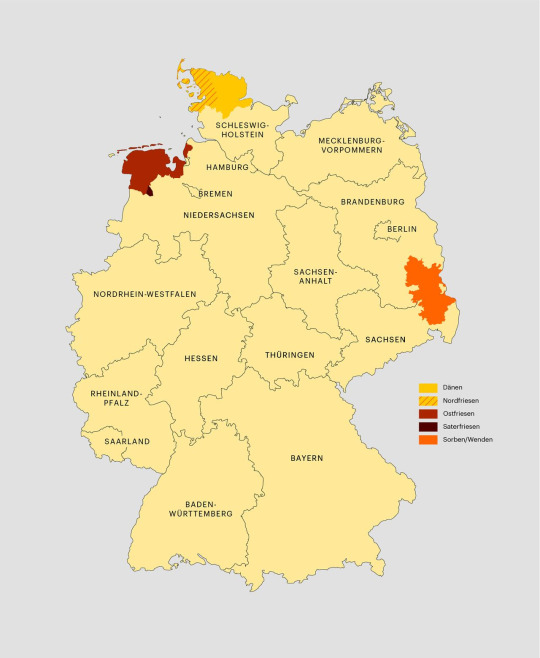
German (Deutsch)
German belongs to the West Germanic group of languages and is the native language of 95 million people. It is the official language in Austria, Belgium, Germany, Liechtenstein, Luxembourg, and Switzerland, as well as South Tyrol in Italy, and is a recognized minority language in ten countries from four different continents.
German Standard German is the standardized variety of German spoken in Germany. Its pronunciation is similar to the German spoken in Hanover. Its alphabet has 30 letters: a b c d e f g h i j k l m n o p q r s t u v w x y z ä ö ü ß. Most German vocabulary is of Germanic origin, but around one fifth was taken from French or Latin. German dialects and varieties are explained in detail in this post.

Romani (rromani ćhib)

Sinte Romani (sintitikes) is the variety of Romani spoken in Germany and neighboring countries. It belongs to the Northwestern Romani dialect group, which in turn is part of the Indo-Iranian branch of the Indo-European family. It is spoken by around 195,000 people and is not mutually intelligible with other Romani varieties.
There is no standard pronunciation or grammar. The alphabet has 31 letters: a b c č čh d dž e f g h i j k kh l m n o p ph r s š t th u v x z ž.
Danish (dansk)
Danish is a North Germanic language with 6 million native speakers. It is the official language of Denmark and the Faroe Islands and a recognized minority language in Schleswig-Holstein and Greenland.
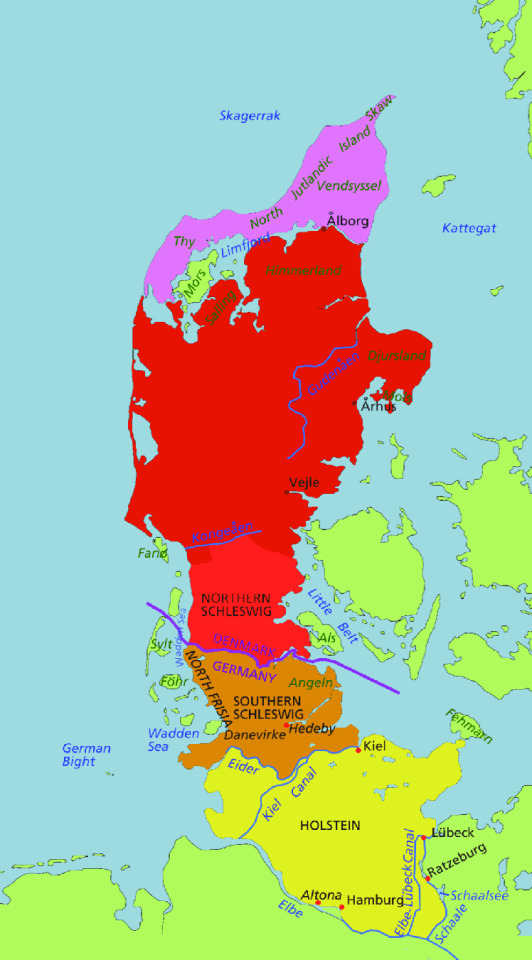
The Danish alphabet has 29 letters, including the 26 found in the English one and æ, ø, and å.
Upper Sorbian (hornjoserbšćina)
Upper Sorbian (Obersorbische Dialekte in the map) belongs to the West Slavic branch and is recognized as a minority language in Saxony, where its 13,000 native speakers live.
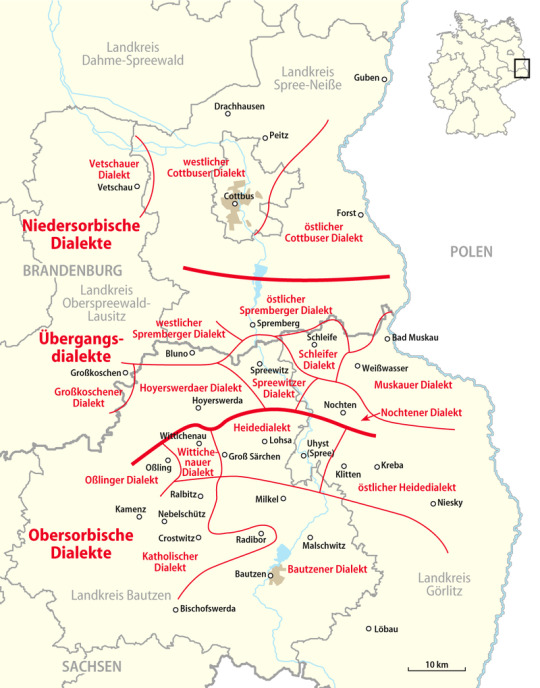
Its alphabet has 34 letters: a b c č ć d dź e ě f g h ch i j k ł l m n ń o ó p r ř s š t u w y z ž.
North Frisian (Nordfriisk)
North Frisian is part of the West Germanic branch and is spoken natively by 10,000 people in Schleswig-Holstein. It comprises 10 dialects, which are divided into two groups: insular and mainland.

Its phonology and orthography vary depending on the dialect, but there are 32 basic letters: a ä å b ch d dj đ/ð e f g h i j k l lj m n ng nj o ö p r s sch t tj u ü w.
Lower Sorbian (dolnoserbšćina)
Lower Sorbian (Niedersorbische Dialekte in the map of Sorbian dialects) is a West Slavic language spoken natively by 6,900 people in Brandenburg.
It uses the same letters as Upper Sorbian but adds ś and ź and uses ŕ instead of ř, bringing the total number of letters to 36.
Saterland Frisian (Seeltersk)
Saterland Frisian belongs to the West Germanic branch and is recognized as a minority language in Lower Saxony. It is spoken by 2,200 people and has three fully mutually intelligible dialects.
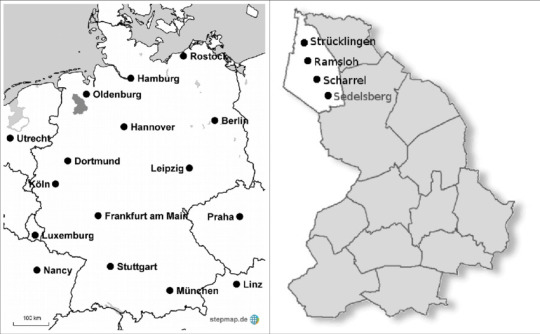
Its orthography has not been standardized yet, but there are 31 common letters: a ä b ch d e f g h i ie j k/kk ks kw l m n ng o oa ö p r s sch t u ü v w.
Here is Article 1 of the Universal Declaration of Human Rights in the native languages of Germany:
German: Alle Menschen sind frei und gleich an Würde und Rechten geboren. Sie sind mit Vernunft und Gewissen begabt und sollen einander im Geist der Brüderlichkeit begegnen.
Romani: Sa e manušikane strukture bijandžona tromane thaj jekhutne ko digniteti thaj capipa. Von si baxtarde em barvale gndaja thaj godžaja thaj trubun jekh avereja te kherjakeren ko vodži pralipaja.
Danish: Alle mennesker er født frie og lige i værdighed og rettigheder. De er udstyret med fornuft og samvittighed, og de bør handle mod hverandre i en broderskabets ånd.
Upper Sorbian: Wšitcy čłowjekojo su wot naroda swobodni a su jenacy po dostojnosći a prawach. Woni su z rozumom a swědomjom wobdarjeni a maja mjezsobu w duchu bratrowstwa wobchadźeć.
North Frisian: Ali Mensken sen frii, likwērtig en me disalev Rochten bēren. Ja haa Forstant en Giweeten mefingen en skul arküđer üs Bröđern öntöögentreer. (Sylt/Sölring dialect)
Lower Sorbian: Wšykne luźe su lichotne roźone a jadnake po dostojnosći a pšawach. Woni maju rozym a wědobnosć a maju ze sobu w duchu bratšojstwa wobchadaś.
Saterland Frisian: Aal do Moanskene sunt fräi un gliek in Wöide un Gjuchte gebooren. Joo hääbe Fernunft un Gewieten meekriegen un schällen sik eenuur as Bruure ferhoolde. (Ramsloh dialect)
Translation: All human beings are born free and equal in dignity and rights. They are endowed with reason and conscience and should act towards one another in a spirit of brotherhood.
5 notes
·
View notes
Text
I’m my research around the Norse pagan sphere I’ve learned some things about runes that I didn’t know before. Here are the three main rune types there are are far more.

Elder Futhark - 2nd Century
Rune, UCS, Transliteration, IPA Proto-Germanic name Meaning
f ᚠ f /ɸ/, /f/ *fehu
"cattle; wealth"
u ᚢ u /u(ː)/ ?*ūruz
"aurochs", Wild ox (or *ûram "water/slag"?)
th,þ ᚦ þ /θ/, /ð/ ?*þurisaz
"Thurs" (see Jötunn) or *þunraz ("the god Thunraz")
a ᚨ a /a(ː)/ *ansuz "god"
r ᚱ r /r/ *raidō "ride, journey"
k ᚲ k (c) /k/ ?*kaunan
"ulcer"? (or *kenaz "torch"?)
g ᚷ g /ɡ/ *gebō "gift"
w ᚹ w /w/ *wunjō "joy"
h h ᚺ ᚻ h /h/ *hagalaz "hail" (the precipitation)
n ᚾ n /n/ *naudiz "need"
i ᛁ i /i(ː)/ *īsaz "ice"
j ᛃ j /j/ *jēra- "year, good year, harvest"
ï,ei ᛇ ï (æ) /æː/[9] *ī(h)waz "yew-tree"
p ᛈ p /p/ ?*perþ-
meaning unknown; possibly "pear-tree".
z ᛉ z /z/ ?*algiz "elk" (or "protection, defence"[10])
s s ᛊ ᛋ s /s/ *sōwilō "sun"
t ᛏ t /t/ *tīwaz "the god Tiwaz"
b ᛒ b /b/ *berkanan "birch"
e ᛖ e /e(ː)/ *ehwaz "horse"
m ᛗ m /m/ *mannaz "man"
l ᛚ l /l/ *laguz
"water, lake" (or possibly *laukaz "leek")
ŋ ŋ ᛜ ŋ /ŋ/ *ingwaz "the god Ingwaz"
d ᛞ d /d/ *dagaz "day"
o ᛟ o /o(ː)/ *ōþila-/*ōþala-
"heritage, estate, possession"
Anglo-Saxon runes
Unicode, Name, Name meaning, Transliteration IPA
ᚠ feh (feoh) wealth, cattle f /f/, [v] (word-medial allophone of /f/)
ᚢ ur (ūr) aurochs u /u(ː)/
ᚦ ðorn (þorn) thorn þ /θ/, [ð] (word-medial allophone of /θ/)
ᚩ os (ōs) heathen god (mouth in rune poem?) o /o(ː)/])
ᚱ rada (rād) riding r /r/
ᚳ cen (cēn) torch c /k/, /kʲ/, /tʃ/
ᚷ geofu (gyfu) gift g /ɡ/, [ɣ] (word-medial allophone of /ɡ/), /j/
ᚹ wyn (wynn) mirth w /w/
ᚻ hægil (hægl) hail h /h/, [x], [ç]
ᚾ næd (nēod) plight n /n/
ᛁ is (īs) ice i /i(ː)/
ᛡ/ᛄ gær (gēar) year j /j/
ᛇ ih (īw) yew tree ï /i(ː)/ [x], [ç]
ᛈ peord (peorð) (unknown) p /p/
ᛉ ilcs (eolh?) (unknown, perhaps a derivative of elk) x (otiose as a sound but still used to transliterate the Latin letter 'X' into runes)
ᛋ/ᚴ sygil (sigel) sun (sail in rune poem?)
s /s/, [z] (word-medial allophone of /s/)
ᛏ ti (Tīw) (unknown, originally god, Planet Mars in rune poem?) t /t/
ᛒ berc (beorc) birch tree b /b/
ᛖ eh (eh) steed e /e(ː)/
ᛗ mon (mann) man m /m/
ᛚ lagu (lagu) body of water (lake) l /l/
ᛝ ing (ing) Ing (Ingui-Frea?) ŋ /ŋg/, /ŋ/
ᛟ oedil (ēðel) inherited land, native country œ /ø(ː)/
ᛞ dæg (dæg) day d /d/
ᚪ ac (āc) oak tree a /ɑ(ː)/
ᚫ æsc (æsc) ash tree æ /æ(ː)/
ᛠ ear (ēar) (unknown, perhaps earth[16]) ea /æ(ː)ɑ/
ᚣ yr (ȳr) (unknown, perhaps bow[18]) y /y(ː)/
Youger Futhark - 8th~12th Century
The names of the 16 runes of the Younger futhark are recorded in the Icelandic and Norwegian rune poems. The names are:
ᚠ fé ("wealth")
ᚢ úr ("iron"/"rain")
ᚦ Thurs ("thurs", a type of entity, see jötunn)
ᚬ As/Oss ("(a) god")
ᚱ reið ("ride")
ᚴ kaun ("ulcer")
ᚼ hagall ("hail")
ᚾ/ᚿ nauðr ("need")
ᛁ ísa/íss ("ice")
ᛅ/ᛆ ár ("plenty")
ᛋ/ᛌ sól ("Sun", personified as a deity—see Sól (Germanic mythology))
ᛏ/ᛐ Týr ("Týr, a deity")
ᛒ björk/bjarkan/bjarken ("birch")
ᛘ maðr ("man, human")
ᛚ lögr ("sea")
ᛦ yr ("yew")
From comparison with Anglo-Saxon and Gothic letter names, most of these names directly continue the names of the Elder Futhark runes. The exceptions to this are:
• yr which continues the name of the unrelated Eihwaz rune;
• thurs and kaun, in which cases the Old Norse, Anglo-Saxon and Gothic traditions diverge.
Min Kilder (My Sources):
Elder Futhark|https://en.m.wikipedia.org/wiki/Elder_Futhark
Anglo-Saxon Runes|https://en.m.wikipedia.org/wiki/Anglo-Saxon_runes
Younger Futhark|https://en.m.wikipedia.org/wiki/Younger_Futhark
4 notes
·
View notes
Text
✩°。⋆⸜ 🦇⋆⸜°。✩
( I n t r ø )
✩- M ø x x i e | +
✩- h e | v a m p
✩- 1 6 y ø
✩- a r t i s t
✩- m l p f a n
✩- m a l e f l u t t e r s h y
✩- u s e s e m o t e s
✩- I support lgbtq, neo/xenopronouns, furries, therians, ect!
✩- please be my friend! >w<
✩- discord: mcxxie
#:3#:)#:D#:]#:>#>w<#16#vampire#vampyr#intro#pinned#neopronouns#xenopronouns#he/vamp#16yo#trans#lgbt#mlp#mlp fan#my little pony
3 notes
·
View notes
Text
oh dont mind me, i just
m ɱ n ɳ ȵ ɲ ŋ ɴ p b t d ʈ ɖ ȶ ȡ c ɟ k ɡ q ɢ ʡ ʔ ɸ β f v θ ð s z ʃ ʒ ʆ ʓ ʂ ʐ ɕ ʑ ç ʝ x ɣ χ ʁ ʩ ħ ʕ ʜ ʢ h ɦ ɬ ɮ ꞎ ʋ ɹ l ɻ ɭ ȴ j ɥ ʎ ɰ ʍ w ʟ ʙ r ɼ ʀ ⱱ ɾ ɺ ɽ ɓ ɗ ᶑ ʄ ɠ ʛ ʘ ɋ ǀ ʇ ǃ ʗ ǂ ʞ ǁ ʖ ¡ ʭ ʬ i ɪ y ɨ ʉ ɯ u ʊ e ø ɘ ɵ ə ɤ o ɛ œ ɜ ɞ ɐ ʌ ɔ æ ɶ a ɑ ɒ b̊ b̥ b̴ b̡ ã a̰ a˞ a̢
m ɱ n ɳ ȵ ɲ ŋ ɴ p b t d ʈ ɖ ȶ ȡ c ɟ k ɡ q ɢ ʡ ʔ ɸ β f v θ ð s z ʃ ʒ ʆ ʓ ʂ ʐ ɕ ʑ ç ʝ x ɣ χ ʁ ʩ ħ ʕ ʜ ʢ h ɦ ɬ ɮ ꞎ ʋ ɹ l ɻ ɭ ȴ j ɥ ʎ ɰ ʍ w ʟ ʙ r ɼ ʀ ⱱ ɾ ɺ ɽ ɓ ɗ ᶑ ʄ ɠ ʛ ʘ ɋ ǀ ʇ ǃ ʗ ǂ ʞ ǁ ʖ ¡ ʭ ʬ i ɪ y ɨ ʉ ɯ u ʊ e ø ɘ ɵ ə ɤ o ɛ œ ɜ ɞ ɐ ʌ ɔ æ ɶ a ɑ ɒ b̊ b̥ b̴ b̡ ã a̰ a˞ a̢
....shame
0 notes
Text
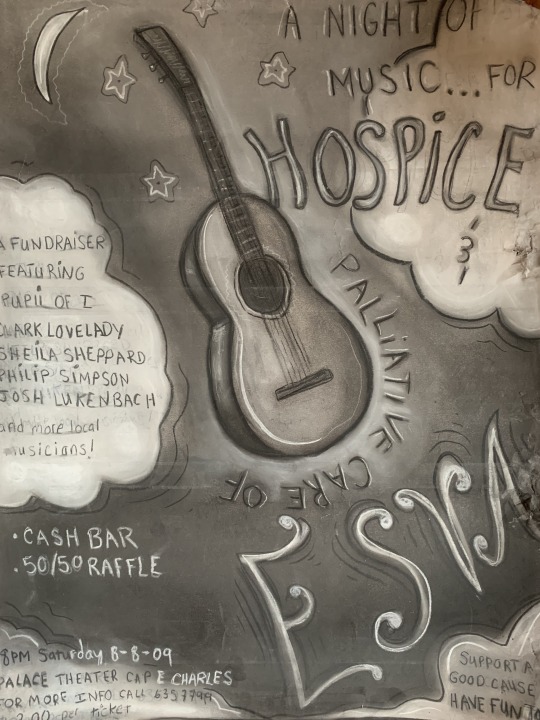
𝘌𝘺𝘦 𝘗𝘶𝘱𝘪𝘭, 𝘳𝘢𝘪𝘴𝘪𝘯𝘨 𝘮𝘰𝘯𝘦𝘺.
𝘝𝘰𝘪𝘤𝘦𝘴 𝘧𝘰𝘳 𝘵𝘩𝘦 𝘰𝘵𝘩𝘦𝘳 𝘴𝘪𝘥𝘦.
𝙀𝙮𝙚 𝙋𝙪𝙥𝙞𝙡, 𝙧𝙖𝙞𝙨𝙞𝙣𝙜 𝙢𝙤𝙣𝙚𝙮.
𝙑𝙤𝙞𝙘𝙚𝙨 𝙛𝙤𝙧 𝙩𝙝𝙚 𝙤𝙩𝙝𝙚𝙧 𝙨𝙞𝙙𝙚.
𝙴𝚢𝚎 𝙿𝚞𝚙𝚒𝚕, 𝚛𝚊𝚒𝚜𝚒𝚗𝚐 𝚖𝚘𝚗𝚎𝚢.
𝚅𝚘𝚒𝚌𝚎𝚜 𝚏𝚘𝚛 𝚝𝚑𝚎 𝚘𝚝𝚑𝚎𝚛 𝚜𝚒𝚍𝚎.
ΣYΣ PЦPIᄂ, ЯΛIƧIПG MӨПΣY.
VӨIᄃΣƧ FӨЯ ƬΉΣ ӨƬΉΣЯ ƧIDΣ.
єує ρυριℓ, яαιѕιηg мσηєу.
νσι¢єѕ ƒσя тнє σтнєя ѕι∂є.
È¥ê þµþïl, råï§ïñg mðñê¥.
Vðï¢ê§ £ðr †hê ð†hêr §ïÐê.
ɆɎɆ ₱Ʉ₱łⱠ, Ɽ₳ł₴ł₦₲ ₥Ø₦ɆɎ.
VØł₵Ɇ₴ ₣ØⱤ ₮ⱧɆ Ø₮ⱧɆⱤ ₴łĐɆ.
乇ㄚ乇 卩ㄩ卩丨ㄥ, 尺卂丨丂丨几Ꮆ 爪ㄖ几乇ㄚ.
ᐯㄖ丨匚乇丂 千ㄖ尺 ㄒ卄乇 ㄖㄒ卄乇尺 丂丨ᗪ乇.
乇リ乇 アひアノレ, 尺ムノ丂ノ刀ム ᄊの刀乇リ.
√のノᄃ乇丂 キの尺 イん乇 のイん乇尺 丂ノり乇.
【E】【y】【e】 【P】【u】【p】【i】【l】【,】 【r】【a】【i】【s】【i】【n】【g】 【m】【o】【n】【e】【y】【.】
【V】【o】【i】【c】【e】【s】 【f】【o】【r】 【t】【h】【e】 【o】【t】【h】【e】【r】 【s】【i】【d】【e】【.】
『E』『y』『e』 『P』『u』『p』『i』『l』『,』 『r』『a』『i』『s』『i』『n』『g』 『m』『o』『n』『e』『y』『.』
『V』『o』『i』『c』『e』『s』 『f』『o』『r』 『t』『h』『e』 『o』『t』『h』『e』『r』 『s』『i』『d』『e』『.』
≋E≋y≋e≋ ≋P≋u≋p≋i≋l≋,≋ ≋r≋a≋i≋s≋i≋n≋g≋ ≋m≋o≋n≋e≋y≋.≋
≋
≋
≋V≋o≋i≋c≋e≋s≋ ≋f≋o≋r≋ ≋t≋h≋e≋ ≋o≋t≋h≋e≋r≋ ≋s≋i≋d≋e≋.≋
░E░y░e░ ░P░u░p░i░l░,░ ░r░a░i░s░i░n░g░ ░m░o░n░e░y░.░
░
░
░V░o░i░c░e░s░ ░f░o░r░ ░t░h░e░ ░o░t░h░e░r░ ░s░i░d░e░.░
(っ◔◡◔)っ ♥ Eye Pupil, raising money.
1 note
·
View note
Text
schedule of date 2023-08-31 :
news : alphabet of language Universal Phonetic Simple Syllabary Nipuponu , phonetic symbol of phonetic alphabet International Phonetic Alphabet of planet Earth :: a A , ä ( open central unrounded vowel ) ; b B , b ( voiced bilabial plosive ) ; c C , ʃ ( voiceless postalveolar fricative ) ; d D , d ( voiced alveolar plosive ) ; e E , e ( close-mid front unrounded vowel ) ; f F , f ( voiceless labiodental fricative ) ; g G , ɡ ( voiced velar polsive ) ; h H , h ( voiceless glottal fricative ) ; i I , i ( close front unrounded vowel ) ; j J , j ( voiced palatal approximant ) ; k K , k ( voiceless velar plosive ) ; l L , l ( voiced alveolar lateral approximant ) ; m M , m ( voiced bilabial nasal ) ; n N , n ( voiced alveolar nasal ) ; o O , o ( close-mid back rounded vowel ) ; p P , p ( voiceless bilabial plosive ) ; q Q , ʒ ( voiced postalveolar fricative ) ; r R , r ( voiced alveolar trill ) ; s S , s ( voiceless alveolar fricative ) ; t T , t ( voiceless alveolar plosive ) ; u U , u ( close back rounded vowel ) ; v V , v ( voiced labiodental fricative ) ; w W , w ( voiced labial-velar approximant ) ; x X , x ( voiceless velar fricative ) ; y Y , y ( close front rounded vowel ) ; z Z , z ( voiced alveolar fricative ) ; å Å , ɒ ( open back rounded vowel ) ; ä Ä , æ ( near-open front unrounded vowel ) ; ö Ö , ø ( close-mid front rounded vowel ) .
0 notes
Text
do you ever just
ftypmp42 mp42mp41iso4 N£moov lmvhd àåTtàåTt »€ ° @ *iods €€€ Oÿÿ)ÿ€€€ €€€ *¼trak \tkhd àåTtàåTt @ @ Æ h *Xmdia mdhd àåTtàåTt < R UÄ 2hdlr vide Vireo Eyes v2.9.1 )þminf vmhd $dinf
dref
url )¾stbl ®stsd žavc1 Æh H H AVC Coding ÿÿ 4avcCM@ÿá
gM@«…üÒÍ@@@P € ñbؘ hèŽË btrt $? åè îX stts © ctts a ÿÿü ÿÿþ ÿÿþ ÿÿü ÿÿþ ÿÿü ÿÿþ ÿÿþ ÿÿü ÿÿþ ÿÿü ÿÿþ ÿÿü ÿÿþ ÿÿþ ÿÿþ ÿÿü ÿÿþ ÿÿþ ÿÿþ ÿÿþ ÿÿü ÿÿþ ÿÿü ÿÿþ ÿÿü ÿÿþ ÿÿþ ÿÿþ ÿÿü ÿÿþ ÿÿü ÿÿþ ÿÿþ ÿÿþ ÿÿþ ÿÿü ÿÿþ ÿÿü ÿÿþ ÿÿü ÿÿþ ÿÿü ÿÿþ ÿÿþ ÿÿü ÿÿþ ÿÿü ÿÿþ ÿÿþ ÿÿþ ÿÿþ ÿÿü ÿÿþ ÿÿþ ÿÿþ ÿÿþ ÿÿü ÿÿþ ÿÿü ÿÿþ ÿÿü ÿÿþ ÿÿü ÿÿþ ÿÿþ ÿÿü ÿÿþ ÿÿþ ÿÿþ ÿÿü ÿÿþ ÿÿü ÿÿþ ÿÿü ÿÿþ ÿÿü ÿÿþ ÿÿü ÿÿþ ÿÿü ÿÿþ ÿÿþ ÿÿþ ÿÿü ÿÿþ
¾ Ñ b ú O 5
§ %e 'U (i ,î 0ã 2 6o :ÿ ! eR k@ m‚ má s§ }1 ƒR ˆ¿ Ù ’o ˜E ¢
¦L ¨S ®F ¶Ô ¹ù º6 À Æë Éõ ÏO ×K ÚH àb çm ê¼ ë ôŒ úÍ ý- ýÚ ®
q $
÷ #{ $à %@ )g -Ï .À 0S 5’ :Œ = >€ BA GÒ LÒ Qx TÈ V‰ oE s¥ v {< Ü ‚C ‡æ † o ‘q –Ï > ¡o £ ¦ó € °j ±h ¹û ¿ Áž Áá Ç Î Ñ£ ÓÊ ÕÐ Ý~ â' ãÜ ä0 êh óï ÷˜ ù ûh 3 — 7 ø à # %& M / /V 4s ;‚ =Ì @° Et H= L¯ V[ [Ä ^C e2 l_ p: pr t{ yÑ }ó …“ ‰" ’: •G ™¸ ›Ó ž" ˜ ¥± « ®‚ ®ç ±Ø ·¼ ¹ì ½| ÃÊ Æí Ê Ð Ð\ Ô Ùš ÝŸ Ýã ß° ú à D ƒ H Ø
á "é -ý /² 5 :0 C
0 notes
Text
I sketched out a PIE clang out of boredom earlier and I kind of liked where it was going but I didn't feel like making a vocab list. Have it
Not Satem
PIE -> Clang
Nucleic sonorants get /a/
*bh -> f
*dh -> z initially, dd elsewhere
*gh -> mostly g initially, gg elsewhere
*kw, gw, ghw -> k, b, bb
*p, t, k, b, d -> mostly same
*s -> always smobile, z between vowels, VsC -> VhC -> VC^2 so like *hest -> ett but *stati -> stat. *sk -> š tho
*r,*l -> metathesize to usually post-vocalic but avoiding m, n, y, w and themselves. *l mostly turns to w after w->v, after vowels and before back vowels. *r tries to turn into *l. *gr and *ghr stop that and just turn into r via an intermediate uvular; h2 was uvular x imo so it also does that (h2r -> r, not l)
*g before e, i merges with y, but not gh
w -> v, y -> ž initially, /j/ otherwise
h1 -> ø, h2 -> h initially, long after a vowel, a-colors. h3-> h initially, w otherwise, a-colors but rounds so basically o-colors
nasals preserved initially, nasalize vowels otherwise
long, nasal vowels raise *oo, *on -> u, *ee, en -> i. Nasal a fronts to e, long a backs to o.
Final short vowel becomes schwa, schwa also inserted after word final geminates
Vowel length transfers to consonant (coda) length if it can.
late a epenthesis before initial clusters
generally clusters simplify as best as possible
Verbs derive from the eventive endings, usually as if they were perfective. Athematic verbs usually like they had -e- before the person endings, thematic verbs usually like they had -a- before the endings, most new verbs are -a- types. Infinitive reflects PIE, the gerund/imperfective participle reflects -nd-, and the original perfect stem was regularized to the reduplicating pattern and used for a new participle with an irregular syllabic n from old -nt-.
So
*bherati -> feratë
egu fere, tu fera, o ferat, nu feremë, yu ferattë, i ferettë
egu fifere, tu fifera, o fiferat, nu fiferemë, yu fiferattë, i fiferettë
stat fereddë
ettë fiferan
*leynkweti -> likketë
egu likke, tu likke, o likket, nu likkimë, yu likkettë, i likkittë
egu lilekkë, tu lilekke, o lilikket, nu lilekkimë, yu lilekkettë, i lilekkittë
stat likkeddë, ettë lilekkan
Noun outcomes would look like their accusative plurals, basically coming out to thematic u stems from the o declension, thematic e stems from the a declension, athematic stems would essentially be consonant stems. A new plural would develop out of the old genitive via a partitive construction and generalize so it's just: u/i, e/i, ø/i, with some irregular things here and there.
*nokwts -> nottë, notti
*dngweh2s -> debbe, debbi
*nisdos -> niddu, niddi
*wergom -> vergu, verži
pronouns are like
nom/obl/pos
egu/mi/miyu
tu/ti/tuyu
o/o/oyu
a/a/ayu
vi/emmí/emmu
yu/vu/yuyu
i/i/iyu
-u -> -e with feminines, -i with plurals (!iyi is eyi)
speakers can say ege if female, or te if speaking to a female, ye females, but this is considered overanalysis and generally done either to sound cute or mildly insult. T-V formality exists; I guess I'm imagining this spoken on some mediterranean island having had contact with Rome.
the oykos stem ends up the counting one but the oynos stem ends up an article. the k demonstrative ends up the definite articles.
ik bi ti kepori pikki seši setti hotti nonni dekki, akiti = 100
post positions and SOV
Hávë 'në, žu o ddë hónnë nérrë váret, éki didérket.
sheep a, REL he to wool not was, horses saw
Ík báru vóggu 'në vivégget;
one heavy wagon a drew
ík méžu fóru 'në;
one big load a
ík nér in hókohóko fiférat.
one man a quickly carried.
Hávë ku éki ki ddë vuvóket:
Sheep the horses the to said:
"Aggímu në aspeki, éki-dë hážetë,
human a see, horses-and draw.INF
kíddë mi aggútari".
heart my pain.PASS
Éki ki o ddë vuvókit:
Horses him to said:
"Kuddí, hávë!
Listen, sheep!
Tó aspékimë,
it we.see
kíddi emmí aggútarit:
hearts our pain.PASS
aggímu në, pótë ku, honnë af hávë bémmu véttru vivépet,
human a, master the, wool of sheep warm clothing made
hávë-dë ku ddë honnë nérrë váret".
sheep-and the to wool not was.
Tó-dë kukúddet, hávë ku hággu ku nnë fufúget.
it-and heard, sheep the field the in fled
1 note
·
View note
Text
For @kangaquollarty53, this was originally made by TheBobby65 on deviantART, so please credit them!
A: Asiatic Wildcat
B: Belgian Malinois Dog/Butterfly hybrid
C: Coati/Squid hybrid
D: Dhole
E: European Hare
F: Florida Panther
G: Goat (Angora)
H: Horse (Clydesdale)
I: Indochinese Tiger
J: Jaguar
K: Kangaroo/Moth hybrid
L: Lorikeet (Iris)
M: Mouse (Striped Field)
N: Norwegian Forest Cat
O: Otter (African Clawless)
P: Polecat (Forest)
Q: Quokka/Slug hybrid (like English one)
R: Riverine Rabbit
S: Skunk (Molina's Hog-nosed)/Snake hybrid
T: Tasmanian Pademelon/Hammerhead Shark hybrid
U: Uinta Ground Squirrel
V: Quail (California)
X: Xoloitzcuintli
Y: Yapok
Z: Zebra (Grevy's)
Æ: Weasel (Japanese)
Ø: Island Fox
Å: Pacific Marten
0 notes